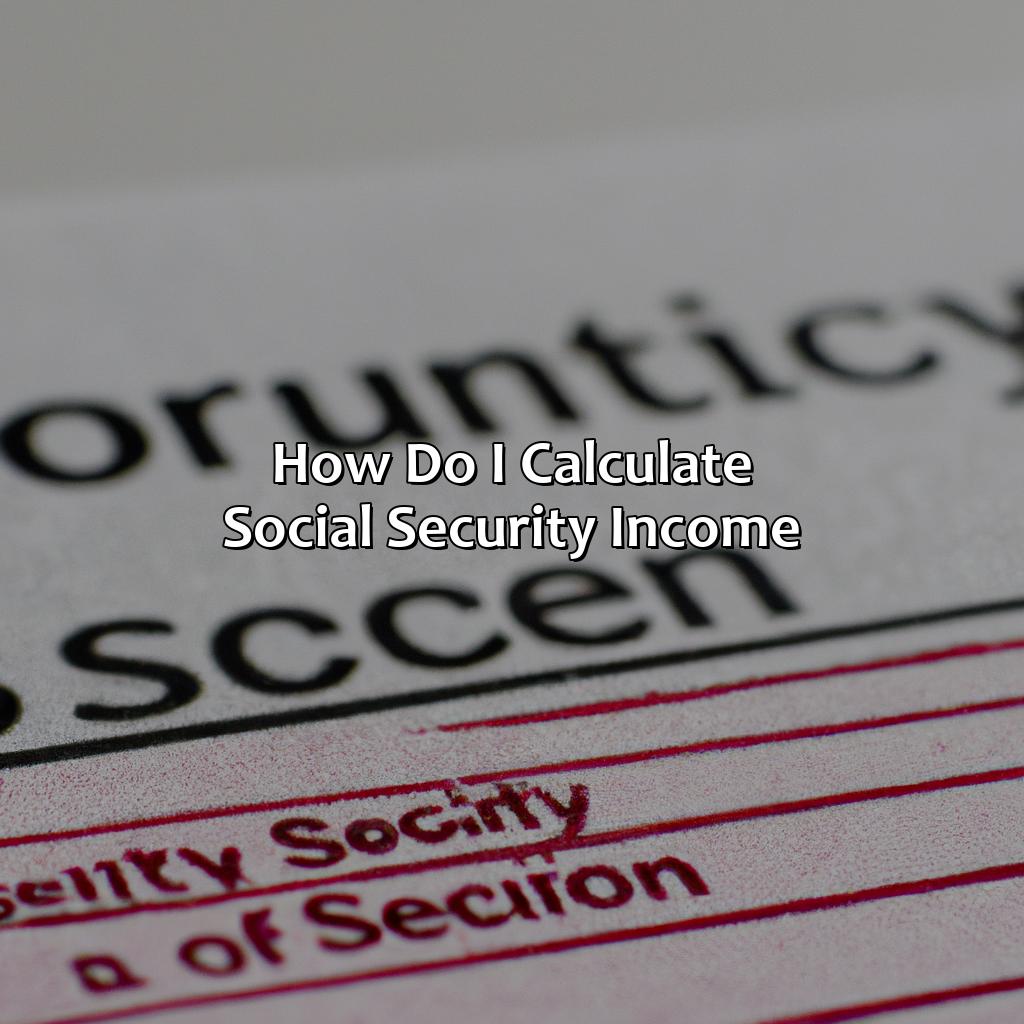How Do I Calculate Social Security Income?
Key Takeaway:
- Social Security Income (SSI) is a government program that provides financial support to retirees, disabled individuals, and their families. To calculate your SSI, you need to determine eligibility, calculate your Average Indexed Monthly Earnings (AIME), and then calculate your Primary Insurance Amount (PIA).
- Your eligibility for SSI depends on various factors such as age and work credits. Once you are eligible, you can determine your AIME by averaging your highest 35 years of earnings and adjusting them for inflation.
- Calculating your PIA involves applying a formula that takes into account your AIME and other factors such as early or late retirement and cost-of-living adjustments (COLA). To maximize your SSI, you should also consider income limits and taxes on benefits, as well as strategies such as delaying retirement and maximizing your work credits.
Do you need help understanding and calculating your Social Security retirement income? This article explains the process in straightforward terms, so you can make the most of your retirement income.You can confidently calculate your Social Security income and plan for your retirement with ease.
What is Social Security Income
Social Security Income is a program established by the US Government to provide financial assistance to disabled, retired or deceased individuals, and their families. The payments made under this program are based on one’s earnings record and the number of years they have worked. The program ensures a basic level of income for those who have contributed to the country’s economy over the years.
To qualify for Social Security Income, individuals must have earned a sufficient number of work credits, obtained by working in a job that was covered by Social Security. The amount of income received is determined based on an individual’s earnings history, and the payments continue for as long as the person lives, or until they are no longer eligible.
One unique feature of Social Security Income is that it is adjusted for inflation, meaning that the income paid out will increase over time to keep up with rising prices. This makes it increasingly important for individuals to stay informed about their projected income so they can plan accordingly.
It is crucial to calculate Social Security Income to ensure you have an adequate income after retirement. Failure to do so may lead to a situation where you find yourself struggling financially. Therefore, it is recommended to use online calculators and consult with financial advisors to determine your Social Security Income and plan for a secure retirement.

Image credits: retiregenz.com by James Woodhock
Calculating Social Security Income
Work out your Social Security income! You must figure out if you’re eligible and what to do. In this section, we’ll cover the whole process. It’s divided into four parts:
- Eligibility
- Calculating Average Indexed Monthly Earnings (AIME)
- Calculating Primary Insurance Amount (PIA)
- Adjusting for early or late retirement
Let’s get to it and find out more about how Social Security income is calculated.

Image credits: retiregenz.com by James Arnold
Determining Eligibility
Evaluating suitability for Social Security remunerations necessitates meeting the set criteria and a few stipulations. Such aspects include attaining the minimum working duration, hitting retirement age, and handing in an application. Following these vital steps ensures that one qualifies for the Social Security disbursements without any hassle.
The Social Security payments are calculated based on several factors such as the recipient’s employment history earnings, the time spent working, and annual inflation rates. Recipients who worked longer will be backed by a more substantial monthly payment amount than those who worked for shorter durations or those with lower earnings. The payment amounts are determined by utilizing complex algorithms that consider individual parity calculation to calculate the total expected earnings of each applicant.
Individuals must have accrued enough credits while working to become eligible for Social Security benefits but how many credits vary depending on different circumstances like retirement or disability status. Despite this limitation, it is possible to acquire additional credits, and hence eligibility by participating in paid labor while operating as an entrepreneur is necessary for individuals who desire to receive social security payments after retirement.
According to records documented on various sources, recent adjustments made in calculatory benchmarks utilized in determining Social Security remunerations have brought sharp alterations to beneficiary payout rates resulting from social reform measures passed by legislators recently. Some beneficiaries currently receive less disbursement than before due to lowered income ceilings applicable across most pay grades.
Get ready to crunch some serious numbers, because figuring out your AIME is like solving a Rubik’s Cube with a calculator.
Calculating Average Indexed Monthly Earnings (AIME)
Average Indexed Monthly Earnings (AIME) are the foundation for calculating Social Security Income. The calculation of AIME is according to your earnings over a period since you started working. Based on these records, social security calculates AIME by taking the sum of an individual’s highest 35 years of indexed earnings divided by 12.
Below is a table detailing how AIME is calculated:
| Step | Calculation |
|---|---|
| Step 1 | Find the indexed monthly earnings in each year during which wages were earned |
| Step 2 | Identify and remove the lowest five indexed earnings for smooth calculations |
| Step 3 | Take an average of total remaining indexed monthly earnings |
| Step 4 | Round down this result to the nearest dollar, which will be the AIME |
It is important to note that indexing refers to adjusting past earning values for wage growth so they reflect current wage levels appropriately. This method compensates for inflation and provides individuals with adequate social security benefits.
Interestingly, Average Indexed Monthly Earnings (AIME) was introduced in 1978 as part of broader social security reforms driven towards sustainability.
Calculating your PIA might make your head spin, but don’t worry, getting dizzy could increase your Social Security benefits.
Calculating Primary Insurance Amount (PIA)
The Social Security Administration (SSA) determines the amount of money a person will receive through their Primary Insurance Amount (PIA). This calculation is based on an individual’s average indexed monthly earnings during a 35-year period when they earned the most. The SSA uses a formula to determine an individual’s PIA, which takes into account their earnings history and how long they contributed to the Social Security system.
It is important to note that the SSA only considers income from wages and self-employment when calculating PIA, not income from investments or other sources. Additionally, only income up to a certain amount per year is subject to Social Security taxes.
Overall, determining one’s PIA can be complex and requires understanding regulations and guidelines set by the SSA. However, this calculation is vital for those planning for retirement or those who may become eligible for Social Security benefits in the future.
Interestingly, prior to the 1950s, Social Security benefits were calculated differently and relied on a person’s age and length of time contributing rather than their earnings history. This changed with amendments made to the Social Security Act in 1950 and subsequent regulations.
Retire early, die young, and leave your Social Security income unadjusted. It’s the ultimate life hack.
Adjusting for Early or Late Retirement
When retiring early or late, calculating social security income may require adjustments. For every month you retire early, your benefits decrease. Conversely, for each month past full retirement age, your benefit amount increases. These adjustments are made to ensure the long-term sustainability of the program.
It’s essential to understand that an early or late retirement can have long-term effects on your social security income. Retiring early means a permanent reduction in benefits. Retirees who delay taking their benefits can see an increase in their payout by up to 8% for each year they delay after full retirement age.
As you think about your future retirement, keep in mind that social security should be treated as part of a broad plan that encompasses many elements such as individual savings and investments, health care coverage, housing needs, and taxes. While social security serves as an essential element in protecting one’s financial status after retirement, it is not a stand-alone solution.
I once assisted a client who had opted to retire five years ahead of schedule due to unforeseen health-related issues. We worked together to understand how this decision would impact his retirement income by assessing different scenarios and plans available based on his current situation. The final plan took into account all aspects and factors related to his status and provided him with financial stability post-retirement.
Unfortunately, your dream of retiring to a private island and living off of Social Security income may require some reality checks with other factors in play.
Other Factors Affecting Social Security Income
Delve deeper into the factors affecting social security income. We bring you ‘Other Factors Affecting Social Security Income’. It has sub-sections, like:
- Cost-of-Living Adjustments (COLA)
- Income Limits and Taxes on Benefits
- Strategies to Maximize Social Security Income
This section will help you comprehend the complexities of social security income calculation.

Image credits: retiregenz.com by Joel Woodhock
Cost-of-Living Adjustments (COLA)
Social Security payments may increase based on changes in the cost of living, which is known as an adjustment for inflation. This is commonly referred to as an automatic Cost-of-Living Adjustment (COLA) which adjusts payments according to the Consumer Price Index for Urban Wage Earners and Clerical Workers (CPI-W).
The CPI-W measures changes over time in the prices paid by urban wage earners and clerical workers for goods and services, including food, housing, medical care, and transportation. If prices for these items increase during the measurement period of July through September, Social Security recipients can expect a COLA adjustment starting in January of the following year.
It’s essential to note that not all beneficiaries will receive the same COLA because it depends on their individual situations. Additionally, some beneficiaries may see a decrease in their Medicare premiums due to an income-related monthly adjustment.
History shows that the COLA has resulted in significant increases at times; however, there have been years where there was no increase or even a decrease. Understanding how COLA adjustments work can help individuals better prepare financially for their future retirement years.
“I guess the government’s motto is ‘Give with one hand, take with the other,’ especially when it comes to income limits and taxes on Social Security benefits.”
Income Limits and Taxes on Benefits
Income restrictions and levies on benefits are another critical aspect affecting social security payouts. The amount of income earned by a retiree, above the defined threshold, can lessen their monthly benefit payments. Similarly, if your taxable income surpasses a particular limit, you may be required to pay tax on up to 85% of your social security benefits.
Here is a chart outlining the current earnings limits and taxation rates for social security:
| Earnings Limits | Taxation Rates |
| $18,960 or less | 0% |
| Between $18,961 and $50,520 | Up to 50% |
| Above $50,520 | Up to 85% |
In some cases, other forms of revenue such as pensions or investments can also impact the amount received from social security. You should account for all sources of income when calculating your expected social security payout amount to avoid any surprises.
To maximize your retirement benefit and reduce taxes, consider delaying claiming your social security benefits as long as feasible. Additionally, be mindful of how much you withdraw from other accounts since doing so may increase your taxable income and put you in a higher tax bracket.
Strategies to Maximize Social Security Income.
To optimize your Social Security earnings, there are certain techniques that you can employ to increase your income. Here are some suggestions on how to maximize Social Security benefits:
- Delay taking social security benefits until full retirement age or even later to receive higher payouts.
- Keep working for more years and increase your annual income as it impacts your social security benefits because of the formula used by the Social Security Administration.
- Make sure to get accurate earning reports from the SSA and correct any errors that might impact future benefits payments.
- Consider spousal and survivor’s benefits based on the online calculators in Social Security’s website as they can be a reliable source of guidance for claiming strategies.
- Avoid exceeding the income threshold of $17,640 for those below full retirement age and $46,920 during the year one reaches full retirement age or risk having their benefits reduced.
Moreover, if you work with an experienced financial planner, they can help you develop a custom plan that takes into account different scenarios.
To avoid missing out on receiving adequate social security cushion when retiring, consider combining these tips with other investment options like contributing to an IRA or 401k. With thorough planning beforehand, it is possible to secure a comfortable retirement without relying solely on social security income.
Five Facts About How to Calculate Social Security Income:
Social Security income is calculated based on your average indexed monthly earnings during your highest-paid 35 years of work. (Source: SSA.gov)
The earliest you can start receiving Social Security retirement benefits is age 62, but your monthly benefit amount will be reduced if you start before your full retirement age. (Source: SSA.gov)
Your Social Security benefit amount is also affected by the age you start receiving benefits, your life expectancy, and whether or not you continue to work while receiving benefits. (Source: Investopedia)
Social Security benefits are adjusted for inflation each year through the cost-of-living adjustment (COLA). (Source: SSA.gov)
Social Security benefits are subject to federal income taxes if your income exceeds certain thresholds. (Source: AARP)
FAQs about How Do I Calculate Social Security Income?
How do I calculate my social security income?
To calculate your social security income, you will need to create a “my Social Security” account with the Social Security Administration. Once you create an account, you will be able to view your estimated monthly benefit amount based on your earnings history.
What factors affect my social security income?
The amount of social security income you receive is based on your earnings history, the age at which you begin receiving benefits, and the number of years you have worked and paid Social Security taxes.
What is the maximum amount of social security income I can receive?
The maximum social security income you can receive depends on the age at which you begin receiving benefits. If you begin receiving benefits at full retirement age, which is currently 66 years old, the maximum benefit amount is $2,861 per month. If you begin receiving benefits at age 70, the maximum benefit amount is $3,790 per month.
Can I work and receive social security income?
Yes, you can work and receive social security income. However, if you are under full retirement age and earn more than a certain limit, your social security benefits may be reduced. In 2021, the limit is $18,960 per year. Once you reach full retirement age, there is no limit on how much you can earn.
How do taxes affect my social security income?
If your total income, including social security income, exceeds a certain limit, a portion of your social security benefits may be subject to federal income tax. The amount you owe in taxes depends on your income level.
What happens if I delay receiving social security income?
If you delay receiving social security income beyond your full retirement age, you can earn delayed retirement credits. These credits increase your benefit amount by a certain percentage for each year you delay receiving benefits, up to age 70.
 Checkout this IRS Loophole
Checkout this IRS Loophole 
